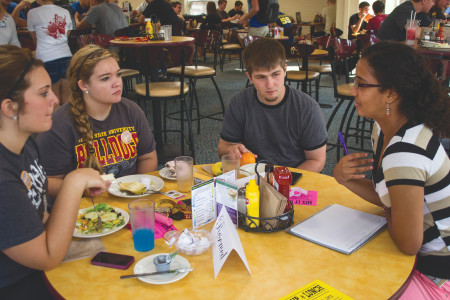
The office of multicultural student services (OMSS) hosted the “Mix it Up” lunch on Sept. 12 at the Westside Café. Students were encouraged to eat lunch with someone of a different background. The event’s goal was to promote diversity by crossing social and cultural boundaries. Approximately 25 students attended the event.
Conversation-starting questions were placed in a bowl at each table. Students spoke on diversity, racism, experience and change.
Ferris junior social work major Ashley Mitchell works at OMSS and attended the event to meet new people. A Leroy native, Mitchell, whose mother is white and father is black, said her hometown lacked diversity.
“I never got to experience much diversity in my life because where I come from, my family is the diversity,” Mitchell said.
Despite organizations and events created to promote diversity awareness, students have differing views on whether Ferris itself is diverse or not. Students talked about the Facebook page, FSU Confessions, in relation to racism. The FSU Confessions page is a page where students can anonymously submit whatever they want. Students discussed how there have been derogatory posts published that target specific cultures or races.
Ferris junior pharmacy major David Robinson, who is white, believes Ferris lacks diversity and has witnessed acts of racism on campus.
“I don’t think it helps that there is an overwhelming amount of white students on campus,” Robinson said. “I think that sometimes [white people] think there is power in numbers, therefore they don’t have to be tolerant and can say, ‘oh we’re surrounded by a bunch of white people and can say what we want. What are the 100 black students –and I know that’s not an accurate number but that’s what it feels like sometimes–going to do?’”
Robinson has felt that he has been racially targeted through university events.
“Organizations that try to bring diversity often bring it in with a skew that tries to put down the white male or female, or just the male in general,” Robinson said.
Some of the students explained how organizations that have the words “black” or “Asian” in the organization name often push students away that do not fit the name. They discussed how everyone is welcome to join those organizations, regardless of the student’s background or ethnicity.
Ferris senior health care systems administration major Jessica Hoang, has felt racism in the community of Big Rapids.
“A little girl, maybe 5 years old, could not stop staring at me [Asian descent] and my [Caucasian] boyfriend when I was at Family Video,” Hoang said. “I feel bad because she is growing up in a town where it’s mostly Caucasians. It’s not her fault, but it’s kind of irritating. I just wish this town could be open to more cultures.”
Mitchell has experienced racism on both sides as she is biracial.
“I have been called the “N” word and have been the root of black jokes. If I didn’t laugh along I was looked at like ‘why wouldn’t you think that was funny?’” Mitchell said.
Dr. David Pilgrim, founder of the Jim Crow Museum and professor of sociology, is an expert on public speaking.
“As an institution we should always be vigilant in all efforts to combat racism, sexism, classism and all other forms of oppression,” Pilgrim said.
“I challenge all students to diversify–or to use an old word, integrate–their organizations, clubs and friendship groups. This is not something that students can be forced to do. They must decide to reach out to others, including others who are different,” he said.
Participants discussed how to bring diversity to campus. Some thought incorporating diversity events into the curriculum based on extra credit would be the incentive for students to participate. Others thought getting RSOs more involved in diversity events would help bring the entire campus together. Students are hopeful for a future without racism and segregation.
“I don’t think racism will ever be gone, but I think a step towards [its end] is society changing the outlook on it, making it even more frowned upon than it is, even now,” Mitchell said.
Michael Wade, assistant director of OMSS, would like to see the number of participants grow in future events.
“Every year that we’ve done ‘Mix it Up’, we’ve had about 40 to 50 students participating each time.”
Students can participate in two more “Mix it Up” events scheduled for Oct. 29 and Nov. 26. The event in October will be hosted by the Communications 366 class from 11a.m. until 1p.m. in the Westside Café.
